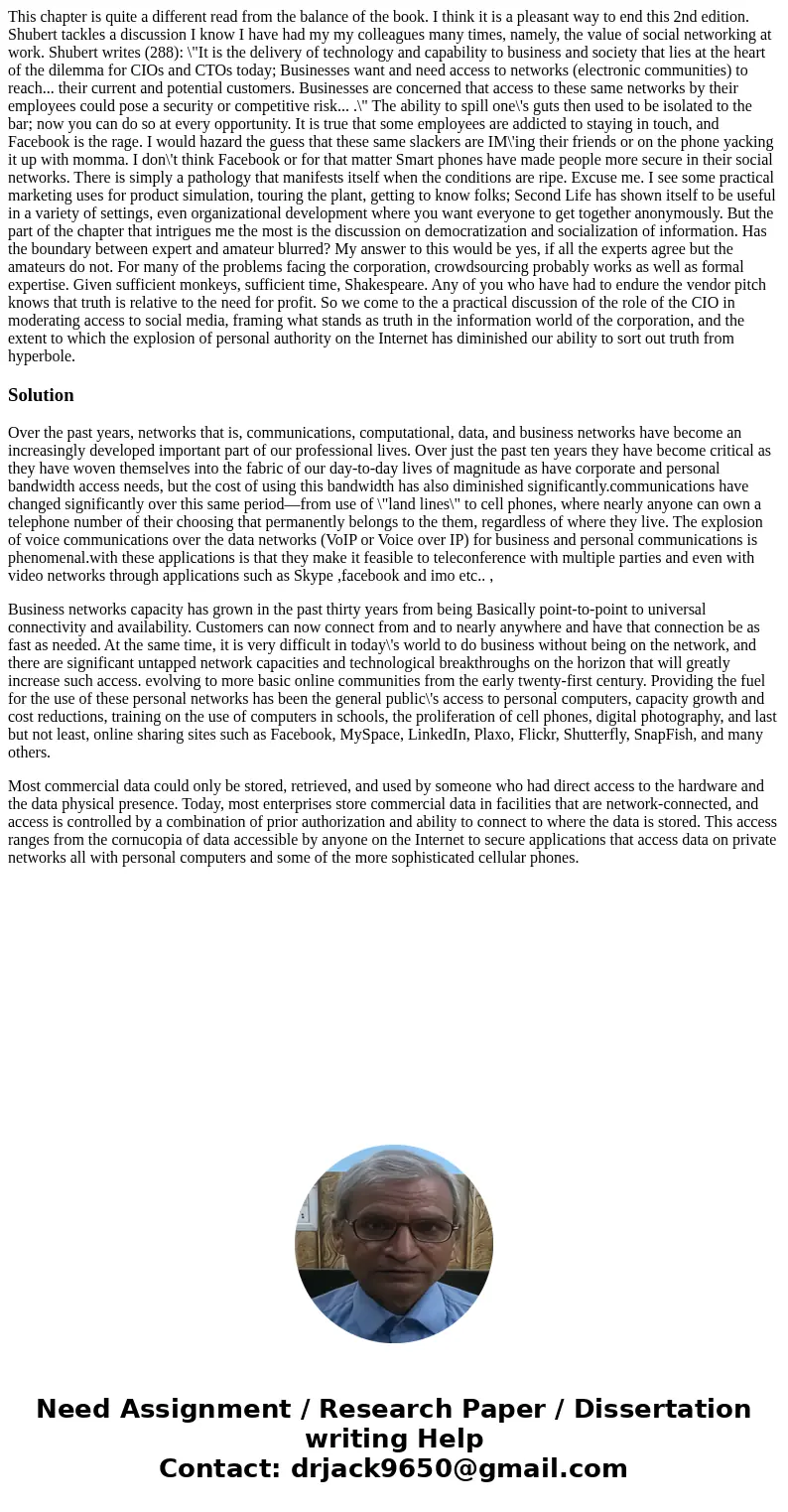This chapter is quite a different read from the balance of t
This chapter is quite a different read from the balance of the book. I think it is a pleasant way to end this 2nd edition. Shubert tackles a discussion I know I have had my my colleagues many times, namely, the value of social networking at work. Shubert writes (288): \"It is the delivery of technology and capability to business and society that lies at the heart of the dilemma for CIOs and CTOs today; Businesses want and need access to networks (electronic communities) to reach... their current and potential customers. Businesses are concerned that access to these same networks by their employees could pose a security or competitive risk... .\" The ability to spill one\'s guts then used to be isolated to the bar; now you can do so at every opportunity. It is true that some employees are addicted to staying in touch, and Facebook is the rage. I would hazard the guess that these same slackers are IM\'ing their friends or on the phone yacking it up with momma. I don\'t think Facebook or for that matter Smart phones have made people more secure in their social networks. There is simply a pathology that manifests itself when the conditions are ripe. Excuse me. I see some practical marketing uses for product simulation, touring the plant, getting to know folks; Second Life has shown itself to be useful in a variety of settings, even organizational development where you want everyone to get together anonymously. But the part of the chapter that intrigues me the most is the discussion on democratization and socialization of information. Has the boundary between expert and amateur blurred? My answer to this would be yes, if all the experts agree but the amateurs do not. For many of the problems facing the corporation, crowdsourcing probably works as well as formal expertise. Given sufficient monkeys, sufficient time, Shakespeare. Any of you who have had to endure the vendor pitch knows that truth is relative to the need for profit. So we come to the a practical discussion of the role of the CIO in moderating access to social media, framing what stands as truth in the information world of the corporation, and the extent to which the explosion of personal authority on the Internet has diminished our ability to sort out truth from hyperbole.
Solution
Over the past years, networks that is, communications, computational, data, and business networks have become an increasingly developed important part of our professional lives. Over just the past ten years they have become critical as they have woven themselves into the fabric of our day-to-day lives of magnitude as have corporate and personal bandwidth access needs, but the cost of using this bandwidth has also diminished significantly.communications have changed significantly over this same period—from use of \"land lines\" to cell phones, where nearly anyone can own a telephone number of their choosing that permanently belongs to the them, regardless of where they live. The explosion of voice communications over the data networks (VoIP or Voice over IP) for business and personal communications is phenomenal.with these applications is that they make it feasible to teleconference with multiple parties and even with video networks through applications such as Skype ,facebook and imo etc.. ,
Business networks capacity has grown in the past thirty years from being Basically point-to-point to universal connectivity and availability. Customers can now connect from and to nearly anywhere and have that connection be as fast as needed. At the same time, it is very difficult in today\'s world to do business without being on the network, and there are significant untapped network capacities and technological breakthroughs on the horizon that will greatly increase such access. evolving to more basic online communities from the early twenty-first century. Providing the fuel for the use of these personal networks has been the general public\'s access to personal computers, capacity growth and cost reductions, training on the use of computers in schools, the proliferation of cell phones, digital photography, and last but not least, online sharing sites such as Facebook, MySpace, LinkedIn, Plaxo, Flickr, Shutterfly, SnapFish, and many others.
Most commercial data could only be stored, retrieved, and used by someone who had direct access to the hardware and the data physical presence. Today, most enterprises store commercial data in facilities that are network-connected, and access is controlled by a combination of prior authorization and ability to connect to where the data is stored. This access ranges from the cornucopia of data accessible by anyone on the Internet to secure applications that access data on private networks all with personal computers and some of the more sophisticated cellular phones.

 Homework Sourse
Homework Sourse